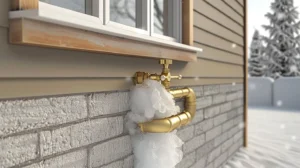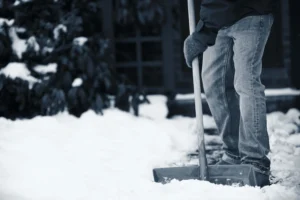Gutters may not be the most glamorous part of your home, but they play a critical role in protecting your property from water damage. By channeling rainwater away from your roof and foundation, gutters help prevent costly problems like roof leaks, foundation erosion, and basement flooding. However, when gutters are clogged, damaged, or neglected, they can’t do their job effectively. The good news? With a little routine care, you can keep your gutters in top shape and avoid expensive repairs. Here are some essential gutter maintenance tips that every homeowner should know.
Clean Your Gutters Regularly
One of the most important gutter maintenance tasks is regular cleaning. Leaves, twigs, dirt, and debris can quickly accumulate in your gutters, especially in the fall. If left unchecked, this debris can cause blockages, leading to water overflowing from the gutters and damaging your home’s exterior, foundation, or landscaping.
- How often to clean: It’s best to clean your gutters at least twice a year—once in the spring and once in the fall. However, if you live in an area with heavy tree coverage or experience frequent storms, you may need to clean them more often.
- How to clean: Use a sturdy ladder to access your gutters and a scoop or small shovel to remove debris. After clearing the larger items, flush the gutters with a garden hose to ensure proper water flow. Be sure to direct the water toward the downspout to check that it’s free of clogs.
For a quicker cleanup, you can also use a leaf blower with a gutter attachment to blow out dry debris.
Check for Gutter Leaks and Damage
While cleaning your gutters, inspect them for leaks, cracks, and damage. Over time, gutters can develop small holes or rust spots, especially if they’re made from older materials. Even minor damage can lead to water leaking onto your home’s siding or foundation, so it’s important to address these issues as soon as possible.
- Patch small holes: For small leaks or holes, use gutter sealant or roofing cement to patch the damage. Apply the sealant to a clean, dry gutter surface, and press down firmly for a tight seal. Larger holes may require a piece of metal flashing or gutter patch kits.
- Check for sagging gutters: Gutters can sag if they become too heavy with debris or if the fasteners have loosened over time. Check for any areas where the gutters are pulling away from your home, and tighten or replace the screws and hangers as needed.
- Examine seams and joints: Gutter seams and joints are common places for leaks. Use a waterproof sealant to reinforce these areas if you notice any gaps or signs of wear.
Ensure Downspouts Are Clear
Downspouts are just as important as gutters when it comes to managing water flow. A clogged downspout can cause water to back up in your gutters and overflow onto your roof and siding. To avoid this, make sure your downspouts are clear of any blockages.
- Check flow: After cleaning your gutters, flush the downspouts with water to ensure they’re draining properly. If the water isn’t flowing freely, use a plumber’s snake or a long pole to clear any clogs.
- Add extensions: Ensure that your downspouts are directing water at least 5-10 feet away from your home’s foundation. If your current downspouts are too short, install extensions or splash blocks to guide the water safely away from your home.
Install Gutter Guards
If cleaning gutters sounds like a chore you’d rather avoid, gutter guards can be a great investment. Gutter guards are protective covers or screens that prevent debris from entering the gutters while still allowing water to flow through. They significantly reduce the frequency of cleaning by keeping leaves, twigs, and other debris out.
- Types of gutter guards: There are several types of gutter guards to choose from, including mesh screens, foam inserts, and reverse-curve systems. Each has its pros and cons, so consider your home’s specific needs and environment when choosing the best option.
- Regular checks: While gutter guards can cut down on cleaning time, they’re not a foolproof solution. You’ll still need to check them periodically to make sure they’re functioning properly and not clogged with smaller debris like dirt or pine needles.
Inspect and Maintain Gutter Fasteners
The fasteners that hold your gutters in place are essential to their function. Over time, screws, nails, and hangers can loosen or wear out, causing gutters to sag or pull away from your home.
- Tighten loose fasteners: During your regular gutter inspections, check for any loose or missing fasteners. Tighten screws and replace any nails or hangers that have come loose. This will ensure that your gutters stay securely in place, even during heavy rain.
- Use proper spacing: Gutter hangers should be spaced no more than 3 feet apart to provide adequate support. If your gutters are sagging or bowing, you may need to add additional hangers to reinforce them.
Watch for Water Pooling Around the Foundation
Even if your gutters seem to be functioning well, it’s important to pay attention to what’s happening around your home’s foundation. If water is pooling near the base of your house, it could indicate a drainage problem with your gutters or downspouts.
- Reposition downspouts: Ensure that your downspouts are positioned to direct water away from the foundation. If necessary, use downspout extensions to carry water farther from the home.
- Grade the landscape: The ground around your home should slope away from the foundation to prevent water from collecting. If you notice low spots or poor drainage areas, regrade the soil or install a drainage system to improve water flow.
Protect Your Gutters in the Winter
Cold weather can be particularly tough on gutters, especially in regions that experience snow and ice. Ice dams can form when snow melts and refreezes at the edge of your roof, creating blockages in your gutters and leading to water damage.
- Clear snow and ice: After heavy snowfall, use a roof rake to remove snow from the edges of your roof. This will prevent ice dams from forming and reduce the weight on your gutters.
- Install heated cables: Heated cables can be installed along the edges of your roof to melt snow and prevent ice dams. These are especially useful in areas that experience frequent freezing temperatures.
- Use de-icing products: Sprinkle de-icing agents, such as calcium chloride, into your gutters to help melt any ice buildup.
Schedule Professional Gutter Maintenance
While regular DIY cleaning and inspections are crucial, it’s also a good idea to schedule professional gutter maintenance at least once a year. Professional gutter cleaners have the tools and experience to thoroughly clean and inspect your gutters, catch any hidden problems, and perform necessary repairs.
Hiring a pro can also be especially useful if your home has multiple stories, steep roofs, or hard-to-reach areas.
Final Thoughts: Keep Your Gutters in Top Shape
Proper gutter maintenance is one of the best ways to protect your home from costly water damage. By cleaning your gutters regularly, inspecting for damage, and addressing small issues before they become major problems, you can keep your home safe and dry all year long. A little bit of maintenance goes a long way, and your gutters—and your home—will thank you for it!









